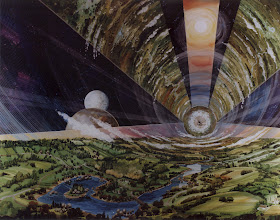Another amazing shot by an amazing astronomical photographer Henry Legault, taken from the Earth. Consider the tracking issues in getting this clear of a shot - the first detailed pic of the ISS from Earth. But that's not my point.
Which is? The ISS is something of a farce, and perhaps only good for the international collaboration it fosters, some basic science, and some technological advances. But other than that, it really doesn't do much other than maintain a human presence in space. But for why? There's no other point, other than to do it. Which I can dig, mind you, but it can't last. The money is too much, the payoff not enough, and the climate here on Earth turning against big costly science projects, without profit. It's all about profits, remember?
Thus I predict the ISS lasts only 10 more years, max - maybe only 5 - before it crashes into the ocean, little gained other than some footnotes in history.
And without some big leap forward, that will be it. The end of humanity in space (unless China saves the day). It's depressing! Since I was raised in the fervor that was Apollo and a widespread belief we'd all be living on the Moon by the year 2000 and all the Solar System would be ours for exploration and colonization. Because isn't that the point of our entire species, of Life itself: To Spread? And surely, from a genetic standpoint, THE most important thing we could ever do is to establish a permanent human colony in space. One that is self sufficient and can grow and develop.
And so I give you a glimpse of a forgotten dream, back when Space itself was to be our Oyster: 1975, from a NASA study of space colonies capable of housing at least 10,000 people.
Two versions of the design, each spinning around enough to create gravity in the central structure and the environments on them.
Groovy and awesome, right? It's 1975! Everything's groovy and awesome. I love the architecture in all these drawings. What's even cooler, the mechanics behind this concept is pretty basic, if obviously massive. But even that can be solved: The idea is you capture an asteroid and tow it to the L4 or L5 Lagrange points, as shown here:
L4 and L5 are basically stable, in that an object there will not move much unless impacted by something else. And so there you have your big iron asteroid and around it you build a space factory - big project, but doable. And from this factory you fashion as much metal as you want to meld into massive space ships. Eventually, you've got colony space ships that can last as long as they are lucky enough to last - which could be a long time. Keep building them and soon enough you are practically guaranteeing humanity will survive no matter what happens.
Debate the merits of that, for they are rich. But I'd hazard we could begin building these ships right now if - IF - all of humanity stopped spending money on armies and navies and missiles and bombs and so on, and instead spent that money getting this project going - a project that would benefit everyone on Earth and in fact every human that has ever lived or ever will live. Doesn't get much bigger and more important than that, does it?
Yeah, right.









"Here's what we can do to change the world, right now, to a better ride. Take all that money we spend on weapons and defenses each year and instead spend it feeding and clothing and educating the poor of the world, which it would pay for many times over, not one human being excluded, and we could explore space, together, both inner and outer, forever, in peace." ~ Bill Hicks
ReplyDeleteBill Hicks was the man.
ReplyDeleteIt's sad and frustrating, yet ultimately inspiring that we could create paradise on Earth if we all chose to do it.
Instead, we engage in petty tribal bickering at scales that threaten us all.
It isn't "What's so funny" but rather "Where's the money in peace love and understanding?"
ReplyDeleteThere is a lot of money to be made squabbling over the last of Earth's resources. I know how you feel though, seeing those photos you posted took me back to grade school and dreaming about such things. I don't know what kids have to dream about nowadays, being famous I guess.
The kids these days!
ReplyDeleteI used to daydream about this particular artwork all the time when a lad. I thought for sure I'd see it with my own eyes, alas! And thus my constant lamentations on the subject. I miss that feeling of reaching for the stars.
Back in middle school, I always hang around the library during recess. And our library had a collection of books from... I dunno the 70's and 80's (I'm talking somewhere 2001).
ReplyDeleteSpace was one of my fascinations back then, and still is. Looking through some of the books on space. It hit me that people back then had a whole thing for space exploration, and even the illustrations were inspiring.
I can't understand how it came from the status in the 70's to the status it is now. It's dissapointing...
»The end of humanity in space« Sincierely hope not :(.
Everything was progressing so fast - space exploration went from Sputnik in 1957 to the Moon in 1969. That's fast! It was only natural to assume (back then) that progress would continue apace and we'd be visiting the Moon for long weekends by now.
ReplyDeleteAlas! Too expensive.